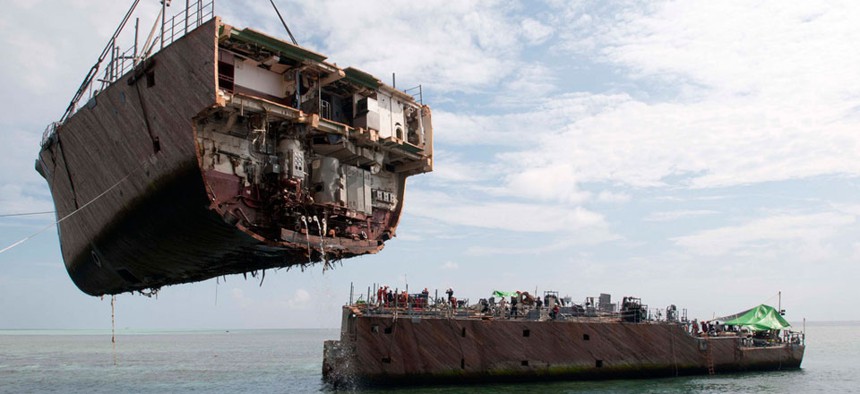How a Misplaced Reef on a Digital Chart Helped Destroy a Navy Minesweeper

The USS Guardian ran aground on the Tubbataha Reef Jan. 17. U.S. Navy
Error by the National Geospatial-Intelligence Agency was compounded by the Navy’s reliance on GPS for navigation.
The National Geospatial-Intelligence Agency misplaced a reef in the Philippine Islands by eight miles on its digital nautical charts, which helped cause the USS Guardian to run aground Jan. 17, destroying the ship.
NGA director Letitia Long told Chief of Naval Operations Adm. Jonathan Greenert that the digital nautical chart display of the Tubbataha Reef in the Sulu Sea was wrong due to erroneous commercial satellite imagery. Long made the assertion in letters obtained by the watchdog website Government Attic.
That error was compounded by “exclusive reliance” of the USS Guardian crew on GPS as a “single source of navigation.” The crew did not pay heed to lighthouses on the reef, according to a 160-page post-wreck investigation report by Adm. Cecil D. Haney, commander of U.S. Pacific Fleet.
The Navy report said the grounding and destruction of the minesweeper also highlighted “potential systemic issues” on ships that use the Navy’s computer based vessel management system and its electronic chart and display system. The vessel management system is supposed to issue audible alerts of potential dangers, but as the Guardian neared the Tubbataha Reef before grounding, the Navy report said watchstanders on the bridge and in the combat information center did not report any alarms.
As the ship neared the reef, personnel on the bridge reported flashes from a lighthouse, but those were ignored as the crew continued to rely on the electronic charts and GPS.
The investigation blamed the grounding primarily on the crew’s failure to reconcile the differences between digital nautical charts of the area and more refined coastal charts. The crew also failed to verify the position of the reef using a list of lighthouses.
The grounding broke the ship’s keel (minesweepers are built of wood to keep from activating mines) when rocks on the reef punched holes in its hull. The crew abandoned ship, with no loss of life.
"USS Guardian leadership and watch teams failed to adhere to prudent, safe, and sound navigation principles, which would have alerted them to approaching dangers with sufficient time to take mitigating action," Haney said.
Long, in her letters to Greenert, said NGA discovered that the charts related to the Tubbataha Reef prior to 2008 included a number of “phantom islands.”
To address this problem, she said the agency used commercial satellite imagery to update the charts. “One of these images included incorrect information about the location of the section of ocean that includes the Tubbataha Reef. As a result, the reef was incorrectly placed in the [digital nautical chart],” Long told Greenert.
In 2011, NGA obtained survey data that corrected this positioning, but due to a failure to follow established procedure, this correction was made in one portion of the DNC, but not in another, Long said, a mistake she attributed to human error.
After the Guardian’s grounding, NGA reviewed DNC charts that cover more than 116 million square miles of ocean, Long told Greenert, and only identified one other significant error, also attributed to commercial satellite imagery: The southern coast of Chile was about 7,000 meters off -- about 4.4 miles. She said correction to the charts “will be worked with the highest priority.”
Editor's note: The headline and first paragraph of this story have been clarified to reflect that the erroneous chart was not the only factor in the grounding of the USS Guardian.
NEXT STORY: DISA Turns on First Joint IT Node






